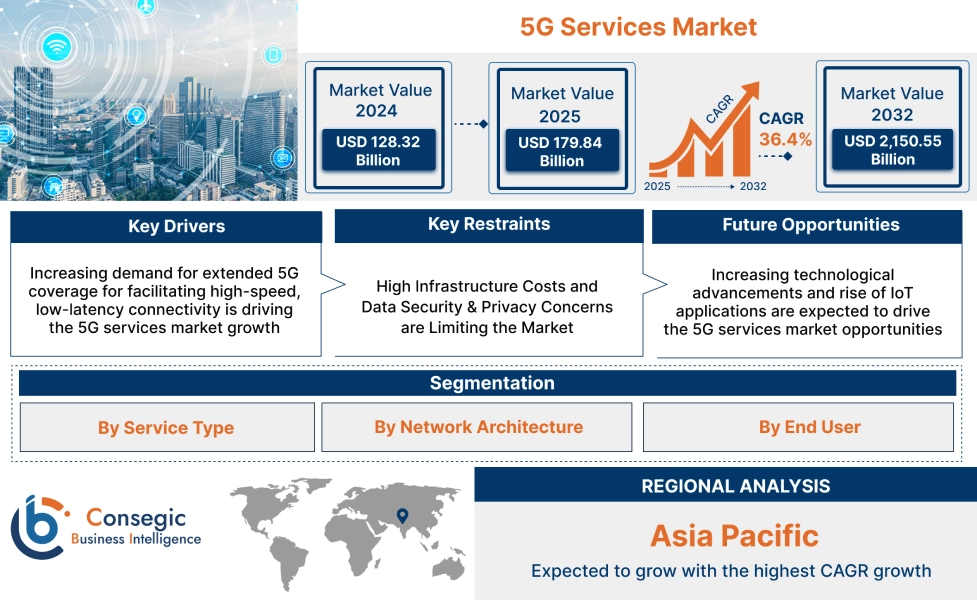5G Services Market Size:
5G Services Market size is estimated to reach over USD 2,150.55 Billion by 2032 from a value of USD 128.32 Billion in 2024 and is projected to grow by USD 179.84 Billion in 2025, growing at a CAGR of 36.4% from 2025 to 2032.
5G Services Market Scope & Overview:
5G is the fifth generation of wireless technology for cellular networks, which offers faster speeds, lower latency, and greater capacity as compared to previous generations such as 4G. Moreover, 5G services enable a wide range of applications for both consumers and businesses, including enhanced mobile broadband, ultra-reliable low-latency communication, and massive machine-type communication, among others. In addition, 5G services offer a broad range of benefits, including higher speeds, lower latency, improved coverage, enhanced mobile broadband, and others.
How is AI Impacting the 5G Services Market?
AI is significantly influencing the 5G services market, driving its growth and evolution. AI-powered solutions are used to enhance performance, optimize 5G networks, and enable new applications. AI solutions are used for analyzing network data in real-time, predicting traffic patterns, and automating network management, which leads to improved efficiency and enhanced user experience. Additionally, AI automates tasks such as network configuration, real-time monitoring and analysis, fault detection, and others, in turn reducing manual intervention and improving efficiency. Consequently, the above factors are expected to drive the market growth in the upcoming years.
5G Services Market Dynamics - (DRO) :
Key Drivers:
Increasing demand for extended 5G coverage for facilitating high-speed, low-latency connectivity is driving the 5G services market growth
The growing demand for extended 5G coverage, driven by the need for high-speed, low-latency connectivity, is a major factor propelling the 5G services market. This increased demand is fueled by the expanding use of 5G for various applications, including internet of things (IoT), augmented reality, automation, remote operations, and others, which require reliable and fast connections. 5G offers significantly faster data speeds and lower latency compared to previous generations, making it ideal for bandwidth-intensive applications. Additionally, the low latency of 5G enables real-time communication and control, which is crucial for applications such as autonomous vehicles, remote surgery, and industrial automation, among others. Further, the rising proliferation of IoT devices is driving the need for a network infrastructure that can handle massive data traffic. 5G provides the capacity and reliability required to support the growing number of connected devices.
- For instance, Telefonica, a Spanish multinational telecommunications company, deployed its 5G services to approximately 1,400 municipalities in Spain in 2022 and 2,400 municipalities by 2023. Additionally, Telefonica installed 700MHz 5G base stations for serving 700 towns and cities throughout Spain as of February 2022.
Thus, the increasing need for extended 5G coverage for facilitating high-speed, low-latency connectivity is driving the 5G services market size.
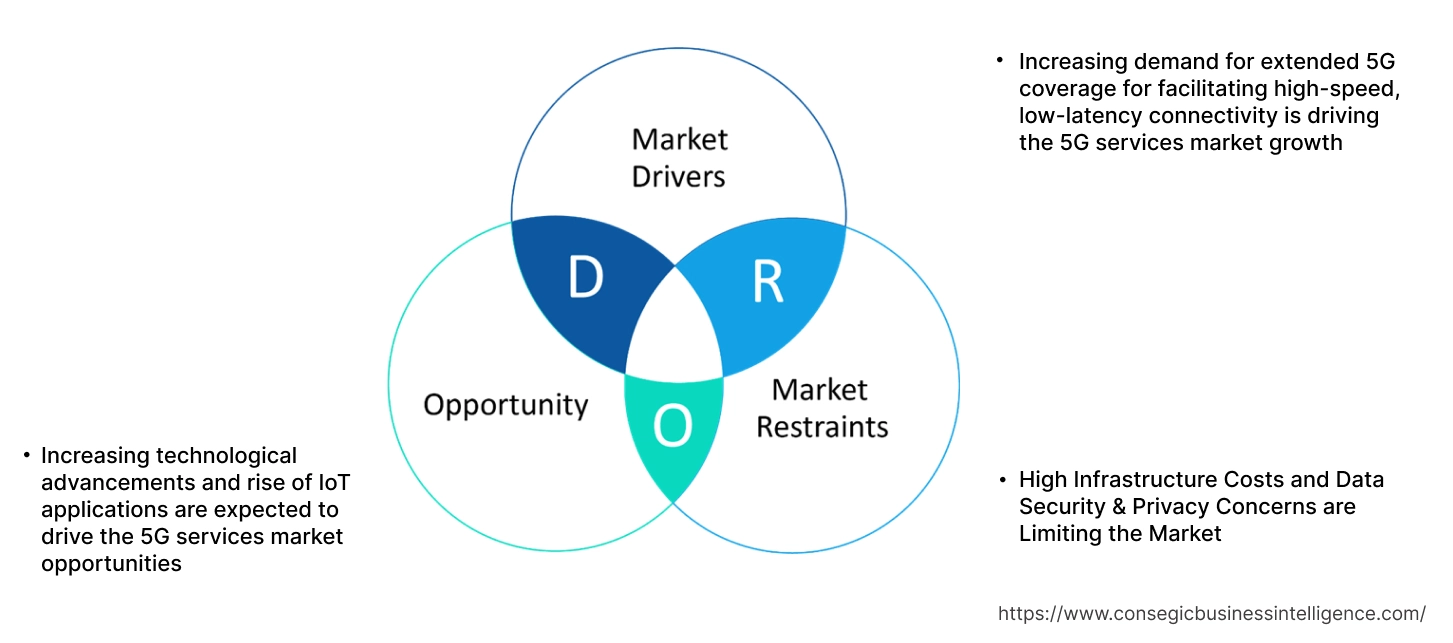
Key Restraints :
High Infrastructure Costs and Data Security & Privacy Concerns are Limiting the Market
High initial investment associated with the deployment of 5G network infrastructure is among the primary factors limiting the market growth. The upfront costs associated with 5G network infrastructure, including costs of equipment, hardware, software, and others, along with integrating them into existing systems can be considerably high, which often leads to financial barriers, specifically for smaller businesses or businesses operating on tighter budgets.
Additionally, 5G networks often require a denser network of cell sites as compared to 4G, thereby increasing the number of hardware installations and associated costs. Thus, the above operational limitations and challenges associated with the deployment of 5G solutions are hindering the 5G services market expansion.
Future Opportunities :
Increasing technological advancements and rise of IoT applications are expected to drive the 5G services market opportunities
5G solutions are crucial for supporting the expanding ecosystem of IoT devices across various industries, including industrial automation, healthcare, transportation, smart cities, and others. Moreover, 5G solutions provide high-speed data transmission and low latency, which are required in several IoT applications such as real-time monitoring systems and autonomous vehicles, among others. In addition, 5G solutions can handle high volumes of connected devices, making it suitable for large-scale IoT deployments in smart cities, industrial automation, and other sectors. As a result, the rise of IoT applications is increasing the need for 5G services to support the growing number of connected devices, in turn driving the market.
- For instance, the total number of IoT devices worldwide reached 17.7 billion in 2024, witnessing a substantial increase from 15.7 billion in 2023 and 13.8 billion in 2022, respectively.
Thus, the increasing technological advancements and rise of IoT applications are projected to boost the 5G services market opportunities during the forecast period.
5G Services Market Segmental Analysis :
By Service Type:
Based on service type, the market is segmented into enhanced mobile broadband (eMBB), ultra-reliable low-latency communications (URLLC), massive machine-type communication (mMTC), and others.
Trends in the service type:
- Increasing trend in adoption of eMBB for supporting applications such as augmented and virtual reality (AR/VR), high-definition video streaming, industrial IoT, and others is driving the market.
- Rising trend in utilization of mMTC in applications involving smart cities, smart agriculture, industrial automation, healthcare, and others, due to its several benefits such as high device density,low power consumption, and improved network performance.
The enhanced mobile broadband (eMBB) segment accounted for the largest revenue share of 48.25% in the 5G services market share in 2024.
- Enhanced mobile broadband (eMBB) focuses on delivering high-speed data and increased capacity to enhance user experience for mobile broadband applications.
- eMBB leverages the capabilities of 5G networks to provide faster speeds, lower latency, and greater capacity compared to previous generations of mobile technology.
- Moreover, eMBB offers several benefits, including higher data rates, improved bandwidth, lower latency, improved multimedia functionality, wider coverage, and others.
- According to the 5G services market analysis, the above benefits of eMBB are further driving its adoption, in turn propelling the market.
The massive machine-type communication (mMTC) segment is anticipated to register a significant CAGR during the forecast period.
- Massive machine type communication (mMTC) is a type of 5G service that enables a massive number of devices, such as sensors in the Internet of Things (IoT), to connect and transmit data, even with low bandwidth and occasional transmissions.
- It is designed to support a high density of devices, potentially up to 1 million per square kilometre, making it ideal for applications that require several devices to communicate with each other or a central system.
- Moreover, mMTC offers various benefits, including high device density,low power consumption, improved network performance, and versatile applications, among others.
- Additionally, mMTC is primarily used in applications involving smart cities, smart agriculture, industrial automation, healthcare, and others.
- Hence, according to the analysis, the above factors are expected to drive the 5G services market size during the forecast period.
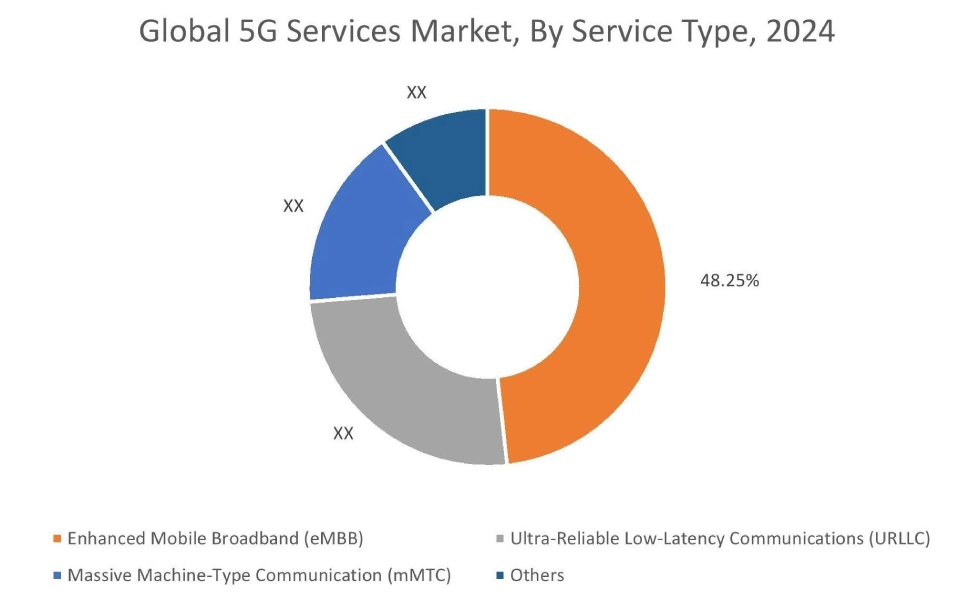
By Network Architecture:
Based on network architecture, the market is segmented into non-standalone (NSA) 5G network and standalone (SA) 5G network.
Trends in the network architecture:
- Rising deployment of non-standalone (NSA) 5G network due to its several benefits including faster deployment,smooth transition to 5G, and relatively lower costs.
- Increasing investments in the deployment of standalone (SA) 5G networks, due to its lower latency, higher speeds, greater capacity, and expanding applications and services, are projected to drive the segment.
The non-standalone (NSA) 5G segment accounted for the largest revenue in the overall 5G services market share in 2024, and it is anticipated to register a significant CAGR during the forecast period.
- A non-standalone (NSA) 5G network is a 5G deployment model that utilizes the existing 4G infrastructure (LTE) to provide 5G services.
- In this network architecture, the 5G radio access network (RAN) is deployed on top of a 4G core network, which enables faster 5G rollout without the immediate need for a completely new 5G core network.
- Further, factors including faster deployment,smooth transition to 5G, enhanced mobile broadband, and relatively lower costs are vital aspects driving the non-standalone (NSA) 5G segment.
- Therefore, the aforementioned factors are projected to drive the 5G services market trends during the forecast period.
By End User:
Based on the end user, the market is segmented into consumer and enterprise.
Trends in the end user:
- There is a rising trend towards the adoption of 5G solutions in business enterprises to fully connect and automate their machines, processes, and data, integrating multiple aspects such as cloud, data management, security, and IoT.
- Increasing adoption of 5G solutions for facilitating faster speeds, lower latency, and increased capacity in consumer applications, involving smartphones, wearables, mobile broadband, home entertainment, smart homes, and others,is driving the market.
The enterprise segment accounted for the largest revenue share in the market in 2024.
- 5G solutions are primarily used for enterprise applications across several industries, including IT & telecommunication, BFSI, healthcare, retail & e-commerce, manufacturing, automotive & transportation, and others.
- It is mainly used in enterprise applications due to its numerous benefits, such as high speed, low latency, and high capacity. This enables faster data transmission, improved connectivity, and the ability to support a larger number of devices simultaneously.
- For instance, Swisscom offers 5G solutions for business enterprises in its solution offerings. The company’s 5G solutions enable business enterprises to fully connect and automate their machines, processes, and data, integrating multiple aspects such as cloud, data management, security, or the Internet of Things (IoT).
- Hence, the rising adoption of 5G solutions in business enterprises isdriving the market growth.
The consumer segment is anticipated to register a substantial CAGR during the forecast period.
- 5G solutions are often used for facilitating faster speeds, lower latency, and increased capacity in consumer applications. This enables improved user experiences in areas such as smartphones and wearables, mobile broadband, home entertainment, smart homes, and others.
- Moreover, 5G's enhanced capabilities are also driving advancements in augmented reality (AR), virtual reality (VR), and cloud gaming, transforming how consumers interact with digital content and services.
- For instance, AT&T Inc. offers 5G wireless service for consumer applications in its solution offerings. The company’s 5G wireless services offer several benefits, such as faster speeds, enhanced network security, and reliable connectivity, among others.
- Consequently, the above factors areexpected to drive the market growth during the forecast period.
Regional Analysis:
The regions covered are North America, Europe, Asia Pacific, the Middle East and Africa, and Latin America.
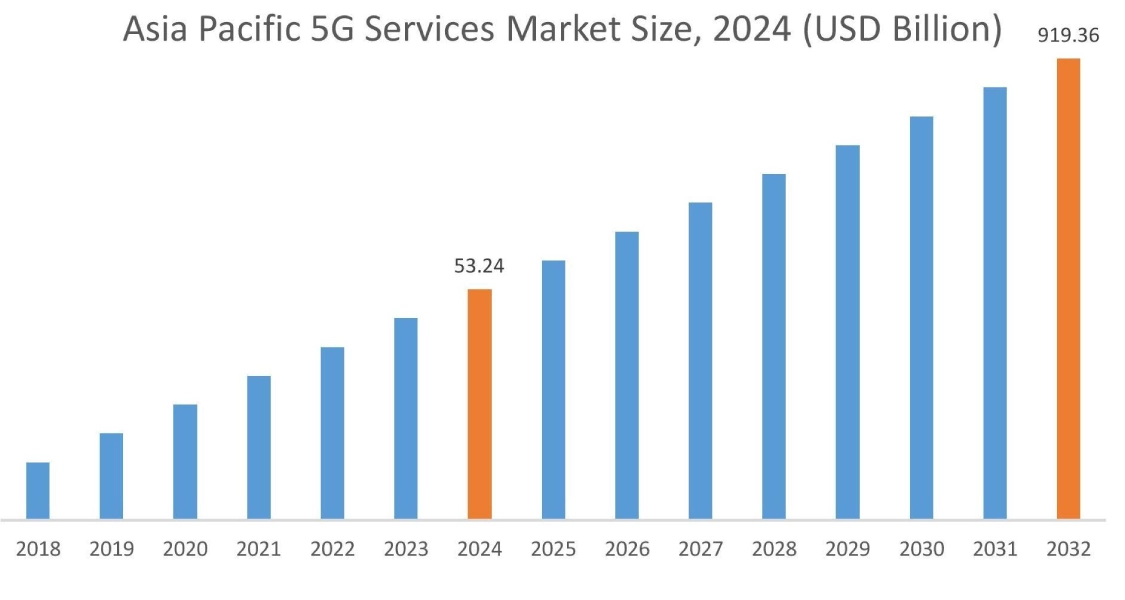
Asia Pacific region was valued at USD 53.24 Billion in 2024. Moreover, it is projected to grow by USD 74.80 Billion in 2025 and reach over USD 919.36 Billion by 2032. Out of this, China accounted for the maximum revenue share of 40.78%. As per the 5G services market analysis, the adoption of 5G solutions in the Asia-Pacific region is primarily driven by the growing IT & telecom, healthcare, and BFSI industry, among others. Additionally, increasing investments in telecom base stations, specifically 5G base stations, are further accelerating the 5G services market expansion.
- For instance, according to the Department of Telecommunication of India, the overall deployment of 5G base stations across India reached up to 464,990 base stations as of December 2024, depicting an increase of 10.8% from 419,845 base stations in January 2024. The above factors are further driving the 5G services market trendsin the Asia-Pacific region.
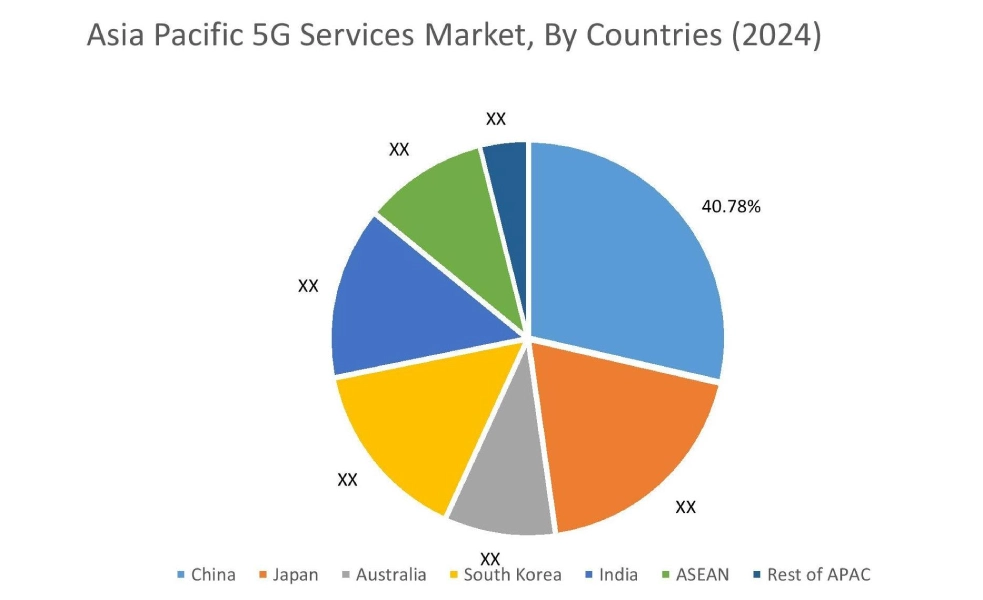
North America is estimated to reach over USD 584.95 Billion by 2032 from a value of USD 35.19 Billion in 2024 and is projected to grow by USD 49.29 Billion in 2025. In North America, the growth of the 5G services industry is driven by growing investments in BFSI, healthcare, retail, manufacturing, and other sectors. Moreover, factors such as rising digital transformation among business enterprises along with increasing need for advanced connectivity and 5G coverage for facilitating digitalization and industrial IoT applications, are further contributing to the 5G services market demand.
Meanwhile, according to the regional analysis, factors including growing manufacturing, BFSI, and healthcare sectors, rising adoption of industrial automation, government initiatives for development of smart cities, combined with the increasing need for advanced connectivity and 5G coverage, are driving the 5G services market demand in Europe. Furthermore, according to the market analysis, the market demand in Latin America, Middle East, and African regions is expected to grow at a considerable rate due to factors such as increasing need for reliable internet and communication services and expanded network coverage for consumer and business applications, among others.
Top Key Players & Market Share Insights:
The global 5G services market is highly competitive with major players providing solutions to the national and international markets. Key players are adopting several strategies in research and development (R&D), product innovation, and end-user launches to hold a strong position in the 5G services market. Key players in the 5G services industry include-
- VIAVI Solutions Inc.(USA)
- ZTE Corporation(China)
- Ericsson (Sweden)
- Orange SA (France)
- Nokia (Finland)
- Swisscom (Switzerland)
- Huawei Technologies Co., Ltd.(China)
- AT&T Inc. (USA)
- Deutsche Telekom AG (Germany)
- Vodafone Group Plc (United Kingdom)
Recent Industry Developments :
Product Launch:
- In May 2024,Nokia and Telefonica in Germany deployed 5G standalone core software on Amazon Web Services (AWS). The rollout aims at providing O2 Telefonica with very low latency for offering advanced 5G services that typically require greater bandwidth capacity and instant availability.
- In February 2023, Orange launched its first commercial 5G standalone (SA) network in Spain, in collaboration with Ericsson. The new 5G technology provides low latency, exceptional user experiences, and advanced security features.
Partnership & Collaboration:
- In July 2024,Nokia and BT Group completed the successful aggregation of 5G Standalone (SA) spectrum by utilizing 5CC CA (Carrier Aggregation). Moreover, 5CC CA aims at considerably increasing the data rates available to customers in high-demand areas by combining all mid-band radio spectrum.
5G Services Market Report Insights :
| Report Attributes | Report Details |
| Study Timeline | 2019-2032 |
| Market Size in 2032 | USD 2,150.55 Billion |
| CAGR (2025-2032) | 36.4% |
| By Service Type |
|
| By Network Architecture |
|
| By End User |
|
| By Region |
|
| Key Players |
|
| North America | U.S. Canada Mexico |
| Europe | U.K. Germany France Spain Italy Russia Benelux Rest of Europe |
| APAC | China South Korea Japan India Australia ASEAN Rest of Asia-Pacific |
| Middle East and Africa | GCC Turkey South Africa Rest of MEA |
| LATAM | Brazil Argentina Chile Rest of LATAM |
| Report Coverage |
|
Key Questions Answered in the Report
How big is the 5G services market? +
The 5G services market was valued at USD 128.32 Billion in 2024 and is projected to grow to USD 2,150.55 Billion by 2032.
Which is the fastest-growing region in the 5G services market? +
Asia-Pacific is the region experiencing the most rapid growth in the 5G services market.
What specific segmentation details are covered in the 5G services report? +
The 5G services report includes specific segmentation details for service type, network architecture, end user, and region.
Who are the major players in the 5G services market? +
The key participants in the 5G services market are VIAVI Solutions Inc. (USA), ZTE Corporation (China), Huawei Technologies Co., Ltd. (China), AT&T Inc. (USA), Deutsche Telekom AG (Germany), Vodafone Group Plc (United Kingdom), Ericsson (Sweden), Orange SA (France), Nokia (Finland), Swisscom (Switzerland), and others.
